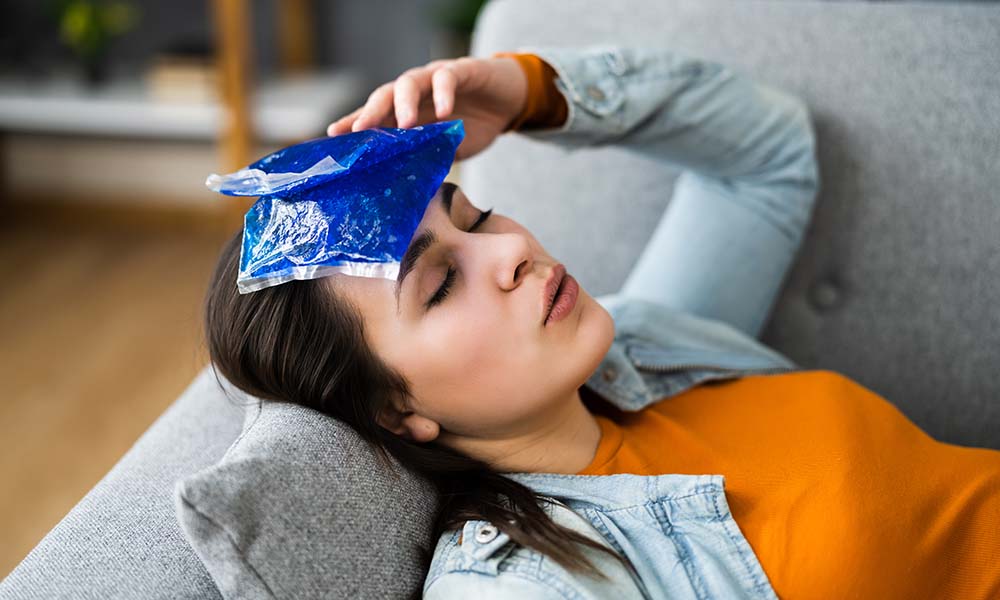18 Home Remedies for Headache Relief - Effective Natural Solutions

TABLE OF CONTENTS
Headaches affect countless individuals daily, with some people experiencing them more than 15 days each month. While tension headaches remain the most common type, research shows that simple factors like dehydration, lack of sleep, and dietary choices can trigger or worsen headache symptoms.
This comprehensive guide explores 18 proven home remedies for headache relief, providing readers with practical, natural solutions they can easily implement at home. Each remedy is backed by scientific research and can be used safely to effectively manage different types of headaches.
Quick Ways to Stop a Headache

Physical discomfort from headaches responds remarkably well to simple home treatments. These remedies can provide quick relief from headaches without the need for medication.
1. Cold Compress Method
Cold therapy stands as one of the most effective ways to address headache pain. Applying an ice pack creates a numbing effect that dulls pain sensations and reduces inflammation. The cooling effect constricts blood vessels, decreasing the transmission of pain signals to the brain.
2. Temple Massage Technique
Massage therapy offers another swift solution for headache relief. It is particularly effective for tension-related pain. The technique works by easing muscle strain and reducing chronic discomfort.
A proper temple massage involves:
Using the middle three fingers to apply firm pressure on both temples
Creating gentle circular motions for 10 seconds
Working along the hairline towards the centre of the forehead
Focusing on the base of the skull and neck muscles
3. Water and Headache Relief
Proper hydration plays a key role in preventing and relieving headaches. Research shows that when the body lacks adequate fluids, the brain temporarily contracts, pulling away from the skull and causing pain.
4. Simple Breathing Exercises
Breathing exercises offer a powerful method for managing headache pain. Clinical studies demonstrate that slow, deep breathing techniques significantly reduce stress levels and relieve tension-related headaches.
To enhance the effectiveness:
Choose a distraction-free environment
Maintain proper posture throughout the exercise
Focus on the sensation of air moving through the throat
Allow the hands to rest comfortably once the proper technique is established
5. Basic Stretches for Pain Relief
Stretching specific muscle groups offers swift relief from headache discomfort.
Neck stretches
Neck stretches specifically target tension at the top of the shoulders, providing immediate relief.
Shoulder rolls
Shoulder rolls effectively release upper body tension that contributes to headache pain. Research indicates that this simple exercise helps alleviate stress in the shoulders, upper back, and neck regions.
6. Foods That Stop Headaches
Dietary choices directly influence headache patterns, with certain foods containing essential nutrients that help prevent and alleviate headache symptoms.
Fruits for relief
Fresh fruits offer natural medicines for headache relief through their rich antioxidant content. Several fruits prove particularly effective:
Bananas, watermelon, cantaloupe, and honeydew provide excellent benefits
Raspberries, blueberries, and strawberries contain powerful antioxidants that combat oxidative stress
Apricots and figs supply essential minerals that support nerve health
Nuts and seeds
Magnesium-rich nuts and seeds play a vital role in headache prevention. Key options include:
Almonds and cashews - excellent sources of magnesium and vitamin E
Flaxseed and chia seeds - rich in omega-3 fatty acids
Pumpkin seeds - provide both magnesium and fibre
Brazil nuts - contain essential minerals that support brain health
7. Drinks That Help Headaches
Herbal teas stand as powerful allies in the battle against headache pain.
Ginger tea - Leads the herbal remedies for headaches in headache relief effectiveness. Studies indicate that ginger might match certain medications in relieving migraine symptoms.
Peppermint tea - Offers dual benefits through its soothing properties and refreshing aroma. The menthol in peppermint works as a natural muscle relaxant, addressing tension that often triggers headaches.
Feverfew tea - Contains parthenolide, which reduces muscle spasms and prevents blood vessel constriction.
Willow bark tea - Features salicin, a compound chemically similar to aspirin.
Clove tea - Traditionally used for various types of pain management
Citron tea - Clinical studies support its ability to reduce both pain intensity and headache duration
8. Proper Sleep
Back or side sleeping positions prove most effective for headache prevention. These positions allow the spine to maintain its natural alignment whilst reducing pressure on nerve endings. For optimal results when sleeping:
Use a supportive pillow with elevated neck support
Place a small cushion beneath the knees when lying on the back
Keep the spine straight when sleeping on the side
Avoid stomach sleeping, which strains neck muscles
To maintain ideal sleeping conditions:
Set the thermostat between 60°F and 65°F before bedtime
Lower temperature gradually by 2-3 degrees each night
Use lightweight bedding materials
Ensure proper air circulation with fans or ventilation
Following consistent sleep patterns helps prevent these early morning headaches. Maintaining regular bedtime hours, avoiding screens before sleep, and creating a dark, quiet environment support better sleep quality.
9. Pressure Points Technique for Relief
Traditional Chinese medicine offers targeted pressure point techniques that effectively alleviate headache pain.
Hand pressure points:
The Union Valley Point, situated between the thumb and index finger, serves as a primary location for headache relief. This pressure point, officially named LI-4 or Hegu, responds well to gentle manipulation. To activate this point:
Position the hand with fingers pointing upward
Locate the highest point of muscle between the thumb and index finger
Apply firm circular pressure for 2-3 minutes
Switch hands and repeat the process
Face pressure points:
Facial pressure points offer direct relief from various types of headaches. The drilling bamboo points, located where the bridge of the nose meets the eyebrows, prove particularly effective for sinus-related discomfort.
Several key facial points include:
Third eye point - Found between eyebrows at the forehead
Gates of consciousness - Located at the base of the skull
Drilling bamboo points - Positioned at inner eyebrow corners
Shoulder well points - Situated halfway between the neck and shoulder
10. Natural Oils for Headaches
Essential oils emerge as potent natural solutions for managing headache discomfort. Research demonstrates that specific oils, primarily peppermint, contain compounds that effectively target pain and associated symptoms.
Peppermint oil stands out amongst natural remedies, containing approximately 44% menthol as its primary active ingredient. Clinical studies indicate that this natural compound helps control blood flow and opens up sinuses for improved oxygen circulation.
Other beneficial oils, in addition to peppermint, include lavender, chamomile, anise, basil, and rose. These alternatives demonstrate similar effectiveness in reducing headache intensity and frequency.
11.Light and Sound Control
Light sensitivity often triggers or intensifies headache symptoms, making proper light and sound management essential for relief. Controlling light and sound reduces sensory overload, effectively promoting relaxation and headache relief.
12. Fresh Air Benefits
Fresh air plays a vital role in managing headache symptoms through its natural cleansing properties.
Poor indoor environmental quality ranks among the severe national environmental threats. Multiple factors affect indoor air quality, including temperature, humidity, and airborne pollutants.
Air purifiers equipped with HEPA philtres effectively remove airborne particles and allergens that might trigger headaches.
Moving outdoors provides immediate relief, as fresh air helps relax tense muscles. Clinical research confirms that outdoor activities combined with proper breathing techniques effectively reduce stress-related headaches.
13. Gentle Exercise
Clinical studies demonstrate that exercise reduces both the frequency and intensity of headache episodes, making it a valuable addition to natural remedies.
Walking benefits:
Walking is one of the safest and most practical exercises for headache relief. Research shows that individuals who incorporate regular walks into their routine experience fewer summer migraine episodes. This gentle activity proves particularly beneficial as it allows practitioners to stay close to home while managing symptoms.
Simple yoga poses:
Yoga emerges as another effective method for headache relief. Clinical research indicates that practising yoga five to six times weekly significantly reduces migraine frequency and intensity. Several poses demonstrate particular effectiveness:
14. Avoid Certain Food Items
Research reveals that specific foods can spark headache episodes in susceptible individuals, making dietary awareness essential for natural headache management.
Several common foods require careful consideration:
Aged Cheeses
Blue cheese
Parmesan
Feta
Cheddar (excluding American, ricotta, cottage, and cream cheese)
Processed Meats
Hot dogs
Bacon
Salami
Ham
Bologna
Additional items warranting caution include:
Chocolate (triggering episodes in 22% of cases)
Fermented foods like kimchi and sauerkraut
Cultured dairy products
Certain fruits (citrus, dried fruits, bananas)
Nuts and nut butter
15. Stress Relief Techniques
Stress management emerges as a cornerstone in preventing tension headaches. Clinical studies demonstrate that managing stress effectively reduces both headache frequency and intensity.
Quick relaxation tips
Rhythmic breathing stands amongst the most potent stress-relief techniques.
Mental imagery relaxation creates harmony between mind and body.
Mindfulness practice, alongside regular meditation, improves pain response and reduces migraine frequency.
Music therapy provides another avenue for stress reduction.
Visualised breathing combines slowed breathing with imagination.
Cognitive Behaviour Therapy (CBT) helps modify thought patterns that increase tension.
16. Natural Pain Relief Plants
Growing medicinal herbs at home provides sustainable natural remedies to cure headaches.
Growing healing herbs
Feverfew, native to the Balkan Mountains, stands amongst the most potent herbs for headache relief. Studies indicate its effectiveness in treating migraines, fever, and arthritis.
Peppermint, created by crossing spearmint and water mint, thrives across North America, Europe, and Asia.
17. Lifestyle Changes to Prevent Headaches
Lifestyle modifications significantly influence headache patterns. Clinical studies demonstrate that consistent daily routines reduce the frequency and severity of migraine attacks.
Morning routine tips:
Starting each day with structured habits creates a foundation for headache prevention. Research indicates that individuals maintaining regular morning schedules experience fewer chronic migraines.
A balanced morning routine encompasses several key elements:
Sleep Schedule Management
Wake at consistent times daily
Avoid weekend schedule changes
Maintain 7-9 hours of nightly rest
Nutritional Planning
Consume six small meals throughout the day
Include protein-rich breakfast
Focus on complex carbohydrates
Add healthy fats to morning meals
Physical Activity Integration
Complete 30-50 minutes of moderate exercise
Practise three to five times weekly
Choose activities like walking or cycling
18. Screen Time Management
Digital screens affect headache patterns through prolonged exposure and improper viewing habits. Clinical studies reveal that individuals looking at screens for two hours without breaks face an increased risk of digital eye strain.
Eye rest breaks:
Extended screen time strains eye muscles, leading to headache onset. Research demonstrates that proper rest intervals significantly reduce eye fatigue and associated discomfort.
The 20-20-20 rule stands as an effective method for preventing screen-related headaches:
Look at objects 20 feet away
Take breaks every 20 minutes
Focus on distant objects for 20 seconds
Studies indicate that implementing regular breaks reduces migraine-related activity limitations. Alongside scheduled breaks, maintaining proper screen distance proves crucial. Positioning screens 25 inches from the eyes minimises strain.
Screen settings:
Monitor placement directly influences headache frequency. Clinical evidence supports positioning screens slightly below eye level to prevent neck strain.
Essential screen adjustments include:
Screen brightness matching the room lighting
Clean, dust-free displays
Anti-glare screen protectors
Proper screen focus
Blue light philtres
Conclusion
Natural remedies offer potent solutions for headache relief without relying on medication. Research proves that simple changes in daily habits, from proper hydration to regular breathing exercises, significantly reduce headache frequency and intensity.
Each person responds differently to various remedies. Some might find immediate relief through cold compresses, while others benefit more from pressure point techniques. The key lies in testing different methods and identifying what works best for individual needs.


